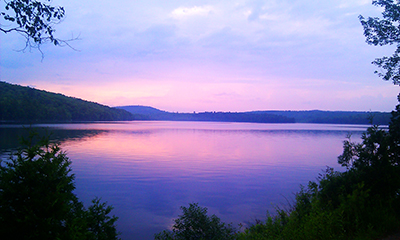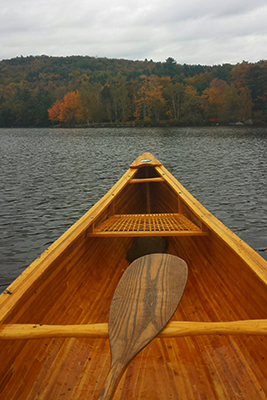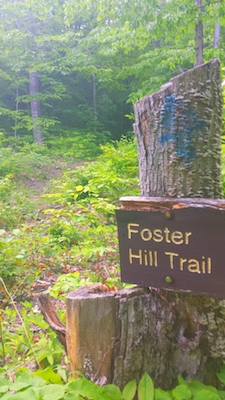Lake George Regional Park
Lake George Regional Park: A Community Effort | June 2017
By Maria Landry
 In 1992, 280 acres on pristine Lake George went up for sale. Developers were interested, but Canaan resident Louise Townsend had a better idea: Wouldn’t it make a wonderful park for the community?
In 1992, 280 acres on pristine Lake George went up for sale. Developers were interested, but Canaan resident Louise Townsend had a better idea: Wouldn’t it make a wonderful park for the community?
According to Lake George Park Corporation Board President Steve Dionne, Townsend convinced Herb Hartman of the Department of Conservation to look at the property.
“She got a canoe and got him into the canoe, and they paddled around the perimeter of the area that was for sale,” Dionne said. “And he must have been impressed, because in 1992 the Department of Conservation, the Land for Maine’s Future, and the Bureau of Parks and Lands all combined to purchase the property.”
Twenty-five years later, Lake George Regional Park—still owned by the state of Maine and operated by the towns of Skowhegan and Canaan—is an incredible success story.

The park comprises the East Side in Canaan and the West Side in Skowhegan, totaling 350 acres due to additional land acquisitions since the original 280 acres were purchased. “The Somerset Woods Trustees have been helpful with that,” Dionne noted. “On two occasions they’ve purchased land and donated it to the park.”
The East Side includes a public boat launch, and both sides offer extensive four-season trails, public beaches, and bath houses. The West Side also features a social hall, complete with stone fireplace and stage, that can be rented for group functions. In the summer the popular Camp Podooc, a day camp, runs for two weeks and serves kids from Skowhegan, Canaan, and Athens.
 Dionne said that yearly attendance, based on gate fees, is about 25,000 per year, but that doesn’t include boat launch users or East Side hikers, as both the boat launch and the Canaan trails are accessible prior to the gate. Attendance could in fact “easily be 30,000 a year,” Dionne observed.
Dionne said that yearly attendance, based on gate fees, is about 25,000 per year, but that doesn’t include boat launch users or East Side hikers, as both the boat launch and the Canaan trails are accessible prior to the gate. Attendance could in fact “easily be 30,000 a year,” Dionne observed.
“It’s really quite fascinating,” he said. “We provide a safe and enjoyable experience for up to 25, 30 thousand people a year, and we basically do it with two employees.”
Those two employees are Derek Ellis, the park director, and new park ranger Taylor Trifone.
“[Trifone] graduated from Unity College two years ago and was an intern at the park,” Dionne said. “It’s great that this is what he’s always wanted to do.”
It’s particularly fitting that a former intern is the new park ranger since Unity College students majoring in parks and forest resources are a summer staple at Lake George.
“Every summer five or six [Unity] students will intern, and we couldn’t do it without them,” Dionne said. “They’re responsible for keeping the bath houses clean, cutting the grass, picking up limbs, working the gates, and registering people for season passes and also for group use. It really wouldn’t be possible without their help.”
He also remarked on how invaluable volunteers are.
“It’s always been a real community effort,” Dionne said.
 He gave as an example the construction of the East Side bath house: “Once the cement block walls were up, the roof system was built at the high school by the vocational department, and we brought it out on my flatbed trailer. Then the students came out and worked at the park for a week erecting the roof and then doing the trim work and the doors and windows. It really is all about community support. We wouldn’t be able to do it if it wasn’t for the generosity of the people who live in the area.”
He gave as an example the construction of the East Side bath house: “Once the cement block walls were up, the roof system was built at the high school by the vocational department, and we brought it out on my flatbed trailer. Then the students came out and worked at the park for a week erecting the roof and then doing the trim work and the doors and windows. It really is all about community support. We wouldn’t be able to do it if it wasn’t for the generosity of the people who live in the area.”
In addition to volunteerism, the community provides important financial support through four annual fundraisers: a spring dinner celebration in June, the Lake George-Somerset Sports & Fitness Triathlon in September, a spaghetti dinner and auction in November, and an annual appeal.
“We just received a grant from the Move More Kids program,” Dionne added. “The intent of that grant is to develop some of our hiking trails so they can be used for mountain bikes. Eventually there’ll be an interconnected set of trails from the trails in Skowhegan all the way out to the park.”
Dionne was also pleased to report that at the spring dinner celebration on June 4, Dan Tilton, senior vice president of sales and customer relations for Skowhegan Savings Bank, announced that the bank is committing $5,000 a year for the next five years in recognition of Lake George’s 25th anniversary.
“That money will be targeted for infrastructure improvements,” Dionne said. “We do need a lot of work. A lot of the buildings are still in disrepair. It’s a lot of infrastructure for the amount of revenue that comes in.”
 Despite ongoing financial needs, Lake George is indeed a sparkling success.
Despite ongoing financial needs, Lake George is indeed a sparkling success.
“It’s one more reason to settle in this area,” Dionne said. “We have a great rec department, we have great schools, fire department, police department, all these things that you would want to have if you want to settle or raise a family—then you throw in Lake George Regional Park, and that’s actually been the reason some people have moved here, because of access to that park.”
Lake George Regional Park is open year-round. Annual passes and group rates are available, and day use fees are $6 for adults, $2 for children ages 5-11, and free for children under 5, senior citizens 65 and older, and disabled veterans. For more information, see LakeGeorgePark.org.
Lake George: A Brief History
Adapted from information found on LakeGeorgePark.org and Modin.com
Early and Middle Archaic Periods (8,000-11,000 years ago)
Evidence of early Paleoindian settlement was first discovered during two archaeological digs undertaken in 1992.
1892
George Washburn built the Mohican House hotel on Podooc Pond and renamed the water body after himself.
1922
Camp Modin, one of the oldest continually operating Jewish camps in the country, was established on the shores of Lake George. The Mohican House was converted into a dining facility. The camp served 45 boys its first year and 110 its second.
1925
On a site across the lake from the boys’ camp, Camp Modin for Girls opened. The girls’ and boys’ sides of the camp continued at Lake George until 1992.
1992
After Camp Modin relocated to the Belgrade Lakes (where it remains today), the property was purchased by the state, becoming Lake George Regional Park—exactly 100 years after George Washburn first built the Mohican House hotel.
2017
Lake George Regional Park celebrates its 25th anniversary!





























